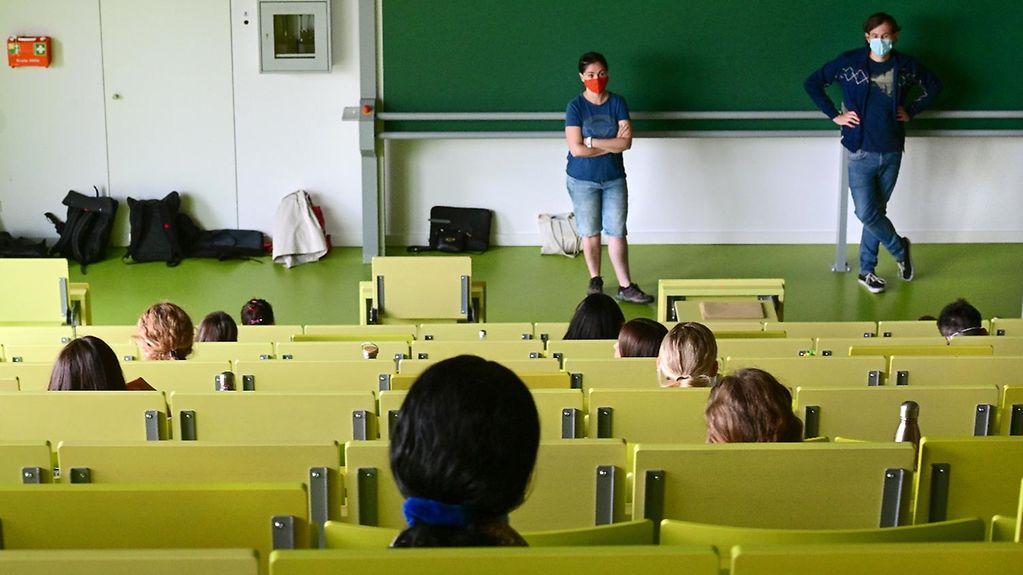Bologna report in the Cabinet
The Bologna Process has been a European success. A reform of European higher education was launched in 1999 under the Bologna Process. The Cabinet has now adopted a report that takes stock of the progress made. Here is a round-up of the main points.
4 min reading time

The Bologna Process has made German degree courses comparable at international level.
Photo: picture alliance/dpa/Uwe Zucchi
The Bologna Process has already achieved a great deal in Europe. It has made higher education systems in different countries comparable with the introduction of bachelor and master’s degrees. Significant progress has been made on the quality and recognition of degree courses. At the same time higher education reform has generated important impetus to make universities more international.
The European higher education reform, known as the Bologna Process, was on the agenda of the Cabinet meeting on Wednesday. The Cabinet has adopted a government report on the implementation of the objectives of the Bologna Process 2000 – 2020. The report takes stock of what has been achieved in the European Higher Education Area (EHEA) over the last 20 years, and demonstrates that the process has been a catalyst for reforms in German higher education.
An overview of the most important points
The number of students at German universities has risen sharply. In the winter semester 2019/2020 almost 2.9 million students were enrolled at German universities. This marks an increase of over 63 per cent compared to winter semester 1999/2000 at the beginning of the Bologna Process.
The range of degree courses at German universities now consists for the most part of bachelor and master’s courses, that are comparable at international level. The total of some 18,700 degree courses leading to a bachelor or master’s degree, account for 91.5 per cent of all degree courses in Germany. By way of comparison, in 2000 bachelor and master’s courses accounted for less than one per cent of degree courses.
The major, overarching goal of the Bologna Process was to create the common European Higher Education Area. Within this area it should be possible to take various elements of a degree course, or a full degree, in another country. The degree conferred or the credit obtained will then be recognised in the other states.
When the Bologna Process was launched in 2000, some 50,000 German students were studying at universities outside Germany. In 2017 a total of 140,000 German students were studying abroad – almost three times as many.
In 2000, some 113,000 international students were enrolled at German universities. In 2019 the figure was almost 320,000 meaning that the number of foreign students studying in Germany has also almost tripled since the start of the Bologna Process. Parallel to this, the mobility of academics has also increased significantly.
The core objectives include the reciprocal recognition of credit and degrees obtained in other countries. This has a direct impact on student mobility and improves the chances of the students of subsequent professional mobility.
In ten states, including Germany, there is now automatic recognition as set out in the Bologna Process. This means that all qualifications (credit and degrees) obtained outside a student’s home country, where there are no significant differences, are treated the same way as credit and degrees obtained in the home country. There is nevertheless scope for improvement in the practical implementation of recognition.
It is the goal of the federal government and of the federal states that students and graduates reflect the diversity of Germany’s population. To this end, various measures and programmes are being implemented to involve under-represented and disadvantaged groups on an equal basis in higher education. This has already enhanced equal opportunities, although there is still more work to be done.
Digitalisation in higher education was mentioned for the first time in 2015 in the communiqué issued at the EHEA Ministerial Conference in Yerevan. Since then, this issue has seen a meteoric development in Germany and in other EHEA states.
Digitalisation can, for instance, help make universities more attractive learning locations. By offering innovative education formats it can make Germany more visible to potential students in other countries, and it can create new ways of accessing education.
In strategic considerations to make Germany more attractive as a centre of science and research, digitalisation thus plays an increasingly important role. It is not only a question of converting in-person learning to online courses. It is also about harnessing the specific additional value that digitalisation brings to universities.
This remains true against the backdrop of the COVID-19 pandemic. All actors within Germany’s science and research system, including the country’s universities, were on track to advance digitalisation before the pandemic. Now we must continue along this path, while integrating the innovations that have proved valuable during the crisis, in a meaningful way in teaching, research and administration.
The German government has launched a wide spectrum of measures to contribute to reforming the country’s higher education system, and continues to foster reforms. These include:
- The Excellence Strategy to strengthen top-level research at universities
- Programmes such as the funding initiative Innovative Hochschule (innovative university)
- The Qualitätspakt Lehre (quality pact for teaching in higher education) to improve study conditions and teaching quality
- Activities to support young academics
- The Hochschulpakt (pact for higher education) to increase student numbers
- The activities of the German Academic Exchange Service (DAAD) to foster mobility
- The Alexander von Humboldt Stiftung, which encourages exchanges among excellent German and non-German academics
- And last, but not least, the AuslandsBAföG, which provides financial support for students studying outside Germany.